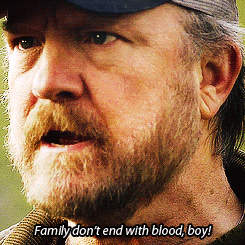King and Robinson both use a much more prominent storyteller voice to tell their stories, rife with repetition, when compared to western literature. However, the structure of Robinson’s tale almost begs for it to be read aloud. The strange grammar, the short sentences or sentence fragments, as well as the physical appearance of the line breaks creates a chaotic and difficult to follow style of communication. When I tried to read it silently in my head, I found it nearly impossible to understand. Reading aloud allows you to experience the story with another sense, so I tried that. When I read it aloud to myself, it was far easier to follow what was happening, and the significance of certain lines. I connected with the piece far more than if I had merely read it in my head.
King, on the other hand, uses the storytelling voice in a friendlier way. Instead of having to almost battle with the language, King’s storyteller voice blends smoothly with the more traditionally western style sections. Green Grass, Running Water seems to be a reconciliation of styles, in the alternating narrative voices, although it is important to recognize the influence of the oral storytelling notes in the more western sections, particularly the repetition in the dialogue between characters.
The presence of the Christian God differs in each narrative. In Robinson’s tale, God is an influence on the world through the messages of an Angel. His only act in this story is to tell Coyote to go make a deal with the King of England, and the Angel speaks in the same grammar pattern as the rest of the narrative style. In King’s story, Coyote is the one that creates God, and God is a rather ridiculous creature that starts out as a Dream. This Dream becomes a Dog with ambition, and then God. Once established as God, He becomes rather distant and aloof, much like the God in Robinson’s tale, but without that Angel to create a further degree of separation.
The Coyotes in each tale are recognizable as the powerful trickster, playing with humans. A fog surrounds Robinson’s Coyote whenever people try to come and take pictures of him. King’s Coyote is revealed (spoiler alert!) is have caused Alberta’s pregnancy, because she wanted a baby but not the hassle of a man.
However, once again, King’s characterization of Coyote is more playful than Robinson’s. Robinson casts Coyote more along the lines of a clever force to be reckoned with. This matches his more solemn version of God, and the overall focus of his piece. King takes a different approach, presenting primarily his fun-loving and chaotic energy. Coyote forgets the consequences of his actions, and several times accidentally creates something: whether that be the Dog-turned-God, a thunderstorm, or perhaps the flood at the end.
For each writer, their portrayals of God and Coyote are to create the specific tone of their work, and to complement the story each is telling. Robinson is telling a story of the origin of “Black and White” law, Indian and European relations. King is telling a story connecting the present to the past, weaving Christian and Indigenous creation myths into the fabric of a story about coming home for the Sun Dance.
WORKS CITED
“Reading Aloud.” The Writing Center at UNC-Chapel Hill. Web. 31 Oct 2016.
Allen, Peter J and Saudners, Chas. “Coyote.” Godchecker. 25 March 2013. Web. 31 Oct 2016.

